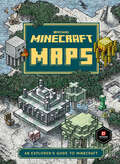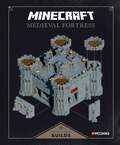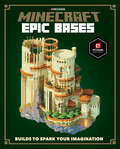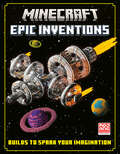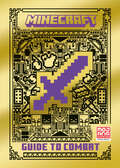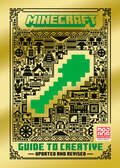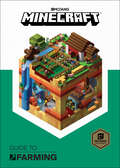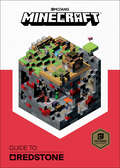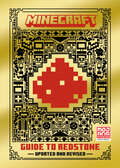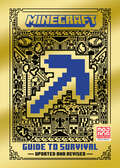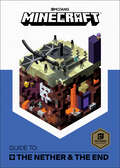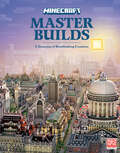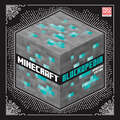- Table View
- List View
Minecraft: An Explorer's Guide to Minecraft (Minecraft)
by Mojang AB The Official Minecraft TeamDiscover the hidden corners of the many weird and wonderful locations in Minecraft with this beautifully illustrated, full-color guide--written in official partnership with the experts at game-creator Mojang.Are you ready for an adventure? Minecraft: Maps is a visual guide to the Minecraft landscape, created by an explorer on a quest to find the most valuable loot while avoiding danger. Explore each of the fifteen major biomes through highly detailed, illustrated maps, then read the explorer's notes about the unique features and discover an inspirational themed build idea for each.A beautifully illustrated visual guide in its own right, Minecraft: Maps is also a survival tool. You'll learn which biomes are home to the most dangerous mobs, where to look for exclusive blocks, how to find naturally generated structures and the best places to search for loot. Once you've discovered each biome you can get building--construct an ice palace in the ice plains biome and an entire village suspended in the tree canopy above the jungle floor.Biomes: Badlands, Dark Forest, Desert, Forest, Jungle, Mountains, Mushroom Fields, Ocean, Plains, Savanna, Snowy Tundra, Swamp, Taiga, The Nether, The End
Minecraft: An Official Mojang Book (Minecraft)
by Mojang AB The Official Minecraft TeamHave you ever wanted to create your own legendary medieval kingdom to rule over? Well, now you can, with Minecraft Exploded Builds: Medieval Fortress. Learn how to design, build, and customize every part of your castle and the surrounding area, from sturdy walls and deadly traps to dank, dark dungeons and sprawling villages. Each build has an exploded view to show you exactly which blocks to use, plus extra ideas to make every part of your kingdom unique. Packed with interesting facts about medieval life, full-color illustrations, and a foldout depicting the epic scale of the kingdom, this official Mojang book has dozens of building ideas to ignite the imaginations of Minecrafters of all ages.This ebook is best viewed on a color device with a larger screen.Collect all of the official Minecraft books:Minecraft: The IslandMinecraft: The CrashMinecraft: The Lost JournalsMinecraft: The Survivors&’ Book of SecretsMinecraft: Exploded Builds: Medieval FortressMinecraft: Guide to ExplorationMinecraft: Guide to CreativeMinecraft: Guide to the Nether & the EndMinecraft: Guide to RedstoneMinecraft: MobestiaryMinecraft: Guide to Enchantments & PotionsMinecraft: Guide to PVP MinigamesMinecraft: Guide to FarmingMinecraft: Let&’s Build! Theme Park AdventureMinecraft for Beginners
Minecraft: Beginner's Guide (Minecraft)
by Mojang AB The Official Minecraft TeamDive into Minecraft headfirst with this all-new beginner&’s guide that will teach you everything you need to know for starting your Minecraft journey, whether that be in Survival mode or Creative. Are you new to Minecraft or still not quite getting the hang of it? Then this book is for you! Join characters such as Miss Hap, Sir Vival and Bill Ding on an adventure through the Overworld, to discover how you can ace your early game.Learn everything from what happens when you die and how to avoid it to how to feed yourself and where to find the cutest mobs. So what are you waiting for? Pick up the book and start your epic adventure!Full of fun and humor, this guide is perfect for kids of all ages.
Minecraft: El libro de las ideas (The Minecraft Ideas Book)
by DKEste libro oficial de Minecraft te trae más de 70 increíbles ideas de construcción, además de los mejores trucos y consejos de constructores expertos.Despierta tu imaginación con ideas inspiradas en el mundo que nos rodea. Descubre datos curiosos y aprende a construir paisajes, maravillas naturales, inventos ¡y mucho más! Desde la Gran Muralla China y la Gran Barrera de coral hasta los trenes de vapor o la Estación Espacial Internacional.Sumérgete en las páginas de este libro de Minecraft y descubre:Cuatro capítulos con diferentes temáticas de construcción: historia, geología, viajes, vehículos…Una lista de datos del mundo real sobre cada modelo para que los niños aprendan a la vez que construyenImágenes ampliadas que muestran con gran detalle cómo se ha construido cada parteSecciones transversales que muestran el interior de los modelos.El libro de las ideas de Minecraft está repleto de ideas: un parque de atracciones, la casa de tus sueños, el campamento base del Monte Everest, una selva tropical con tirolesa y mucho más. ¡Observa el mundo real y el de Minecraft como nunca antes lo habías hecho! -------------------------------------------Discover more than 70 mind-blowing build ideas – plus tips, tricks, and hacks from expert Minecraft builders in this official Minecraft book.Spark your imagination with incredible build ideas inspired by the world around us. Explore landmarks, natural wonders, and inventions. From the Great Wall of China and the Great Barrier Reef, to steam trains and the International Space Station, learn how to build them all in Minecraft – and discover fascinating facts about them, too. The Minecraft Ideas Book is packed with all kinds of imaginative build ideas, including a cross-section of a volcano, ideas for designing your dream house, a fabulously fun theme park, a Mount Everest base camp, a rainforest with zip-wire, and much, much more. Why not step back in time to build the Titanic or a Roman chariot race or fast-forward to the future and build a sustainable city? Anything is possible! What will you build first? Find building techniques, hints, and tips throughout, such as block hacks, planning tips, and ideas for customizing. Meet the expert builders and discover where they get their ideas from. See the Minecraft world – and the real world – as you’ve never seen it before! © 2023 Mojang AB.
Minecraft: Epic Bases (Minecraft)
by Mojang ABDiscover new and exciting Minecraft base builds, with construction tips, blueprint spreads, and fun locations—written in official partnership with the experts at game-creator Mojang.Are you an expert builder? Looking for inspiration for your next epic build? Then the search is over!Visit the legendary bases of The Twelve, a guild of expert builders, who are ready to showcase their most stunning creations, including flying airships and underwater lairs. Learn their top tips and tricks for making incredible bases in a variety of themes, and follow their expert advice to create challenging structures and complex redstone mechanisms.Full of thematic builds and unique features, this book of exceptional bases will spark the imagination of Minecrafters young and old.
Minecraft: Epic Inventions (Minecraft)
by Mojang AB The Official Minecraft TeamTwelve mind-blowing Minecraft builds to spark your imagination.Epic Inventions contains twelve incredible builds to inspire you to construct the most inventive builds in Minecraft. There's an intergalactic space station, an ancient temple, a kawaii waterways course, a giant meeple bedroom, an animal sanctuary, plus many more. Each build is presented to you by its builder—a construction expert eager to share their tips with you. As well as learning how to choose blocks and construct amazing builds, you'll also learn some excellent pro builder tips like how to terraform the landscape.
Minecraft: Guide to Combat (Minecraft)
by Mojang AB The Official Minecraft TeamLearn how to survive and thrive in Minecraft with this brand-new guide! With insider info and tips from the experts at game-creator Mojang on how to defeat mobs and defend your base, this is a must-have, fully illustrated guide to combat. Don your armor, pick up your sword and charge headfirst into Minecraft: Guide to Combat—the only book you need to take your game to the next level. Read how to craft the deadliest weapons and enchant them with mystical powers, discover the vicious mobs that you&’ll go toe-to-toe with, and learn crafty strategies that will help you best your friends in PVP. With so much to explore, there&’s sure to be something for &’crafters of every level.
Minecraft: Guide to Creative (Minecraft)
by Mojang AB The Official Minecraft TeamThe official Minecraft: Guide to Creative will teach you all you need to know to create builds more impressive than you could&’ve dreamed of.The world of Minecraft is so varied and limitless that incredible creations can often be daunting to think about, never mind to build. With insider info and tips from the experts at Mojang, this is the definitive guide to creation in Minecraft.This ebook is best viewed on a color device with a larger screen.Collect all of the official Minecraft books:Minecraft: The IslandMinecraft: The CrashMinecraft: The Lost JournalsMinecraft: The Survivors&’ Book of SecretsMinecraft: Exploded Builds: Medieval FortressMinecraft: Guide to ExplorationMinecraft: Guide to CreativeMinecraft: Guide to the Nether & the EndMinecraft: Guide to RedstoneMinecraft: MobestiaryMinecraft: Guide to Enchantments & PotionsMinecraft: Guide to PVP MinigamesMinecraft: Guide to FarmingMinecraft: Let&’s Build! Theme Park AdventureMinecraft for Beginners
Minecraft: Guide to Creative (Minecraft)
by Mojang AB The Official Minecraft TeamThis classic Minecraft game guide is now completely revamped with 100% new information for the latest version of the game! Discover all the insider tips and tricks in this definitive, fully illustrated guide to creative mode in Minecraft.Minecraft is a sandbox game where anything is possible! With over 600 blocks to choose from, getting started can feel overwhelming. This updated guide will give you all the tools you need to become an expert builder. Whether it&’s choosing your blocks or decorating your build, this book is packed with expert advice, top tips and advanced tricks to take your construction skills to the next level. Read how to plan builds, create color palettes, use effective lighting and much more. This book also features advice from pro build teams and YouTubers, and includes step-by-step builds to complete in-game. With so much to explore, there&’s sure to be something for &’crafters of every level.
Minecraft: Guide to Exploration (Minecraft)
by Mojang AB The Official Minecraft TeamThe official Minecraft: Guide to Exploration will help you survive. Learn how to find resources, craft equipment and protect yourself from hostile mobs.The world of Minecraft is waiting to be explored. But danger lurks around every corner and survival can prove difficult for even the bravest adventurer. With insider info and tips from the experts at Mojang, this is the definitive guide to exploration for new Minecrafters.This ebook is best viewed on a color device with a larger screen.Collect all of the official Minecraft books:Minecraft: The IslandMinecraft: The CrashMinecraft: The Lost JournalsMinecraft: The Survivors&’ Book of SecretsMinecraft: Exploded Builds: Medieval FortressMinecraft: Guide to ExplorationMinecraft: Guide to CreativeMinecraft: Guide to the Nether & the EndMinecraft: Guide to RedstoneMinecraft: MobestiaryMinecraft: Guide to Enchantments & PotionsMinecraft: Guide to PVP MinigamesMinecraft: Guide to FarmingMinecraft: Let&’s Build! Theme Park AdventureMinecraft for Beginners
Minecraft: Guide to Farming (Minecraft)
by Mojang AB The Official Minecraft TeamThe official Minecraft: Guide to Farming will teach you about everything form basic crop farming and animal breeding to hostile mob and block farming. In Survival mode you&’re constantly in need of food and other useful items, and true survivors knows the importance of setting up their own farming systems. With insider info and tips from the experts at Mojang, this is the definitive guide to becoming self-sufficient in Minecraft.This ebook is best viewed on a color device with a larger screen.Collect all of the official Minecraft books:Minecraft: The IslandMinecraft: The CrashMinecraft: The Lost JournalsMinecraft: The Survivors&’ Book of SecretsMinecraft: Exploded Builds: Medieval FortressMinecraft: Guide to ExplorationMinecraft: Guide to CreativeMinecraft: Guide to the Nether & the EndMinecraft: Guide to RedstoneMinecraft: MobestiaryMinecraft: Guide to Enchantments & PotionsMinecraft: Guide to PVP MinigamesMinecraft: Guide to FarmingMinecraft: Let&’s Build! Theme Park AdventureMinecraft for Beginners
Minecraft: Guide to Ocean Survival (Minecraft)
by Mojang AB The Official Minecraft TeamThe official Minecraft: Guide to Ocean Survival will teach you how to breathe underwater, find valuable sunken loot and fight off guardians and other menacing mobs of the deep.Minecraft&’s oceans are teeming with colorful life and rare treasures, but new dangers lurk beneath the water and survival can prove difficult. With insider info and tips from the experts at Mojang, this is the definitive guide to underwater survival.This ebook is best viewed on a color device with a larger screen.Collect all of the official Minecraft books:Minecraft: The IslandMinecraft: The CrashMinecraft: The Lost JournalsMinecraft: The Survivors&’ Book of SecretsMinecraft: Exploded Builds: Medieval FortressMinecraft: Guide to ExplorationMinecraft: Guide to CreativeMinecraft: Guide to the Nether & the EndMinecraft: Guide to RedstoneMinecraft: MobestiaryMinecraft: Guide to Enchantments & PotionsMinecraft: Guide to PVP MinigamesMinecraft: Guide to FarmingMinecraft: Let&’s Build! Theme Park AdventureMinecraft for BeginnersMinecraft: Guide to Ocean Survival
Minecraft: Guide to PVP Minigames (Minecraft)
by Mojang AB The Official Minecraft TeamThe official Minecraft: Guide to PVP Minigames contains some of the best games for you to re-create and play with friends in your own world. When it comes to making your own fun in Minecraft, the player-versus-player minigame options are endless, and the only limit is your imagination. With insider info and tips from the experts at Mojang, this is the definitive guide to building and playing PVP minigames in Minecraft. This ebook is best viewed on a color device with a larger screen. Collect all of the official Minecraft books:Minecraft: The IslandMinecraft: The CrashMinecraft: The Lost JournalsMinecraft: The Survivors&’ Book of SecretsMinecraft: Exploded Builds: Medieval FortressMinecraft: Guide to ExplorationMinecraft: Guide to CreativeMinecraft: Guide to the Nether & the EndMinecraft: Guide to RedstoneMinecraft: MobestiaryMinecraft: Guide to Enchantments & PotionsMinecraft: Guide to PVP MinigamesMinecraft: Guide to FarmingMinecraft: Let&’s Build! Theme Park AdventureMinecraft for Beginners
Minecraft: Guide to Redstone (Minecraft)
by Mojang AB The Official Minecraft TeamLearn the art of redstone and become a master engineer with Minecraft: Guide to Redstone, then put theory into practice to construct intricate contraptions in Minecraft. Pick up the basics of the redstone components and their uses, discover how to make working circuits, and create incredibly complex builds using your new skills. With insider info and tips from the experts at Mojang, this is the definitive guide to redstone in Minecraft.This ebook is best viewed on a color device with a larger screen.Collect all of the official Minecraft books:Minecraft: The IslandMinecraft: The CrashMinecraft: The Lost JournalsMinecraft: The Survivors&’ Book of SecretsMinecraft: Exploded Builds: Medieval FortressMinecraft: Guide to ExplorationMinecraft: Guide to CreativeMinecraft: Guide to the Nether & the EndMinecraft: Guide to RedstoneMinecraft: MobestiaryMinecraft: Guide to Enchantments & PotionsMinecraft: Guide to PVP MinigamesMinecraft: Guide to FarmingMinecraft: Let&’s Build! Theme Park AdventureMinecraft for Beginners
Minecraft: Guide to Redstone (Minecraft)
by Mojang AB The Official Minecraft TeamThis classic Minecraft game guide is now completely revamped with 100% new information for the latest version of the game! Discover all the insider tips and tricks in this definitive, fully illustrated guide to creating with redstone in Minecraft.Learn the art of redstone and become a master engineer with Minecraft: Guide to Redstone, and put theory into practice to construct intricate contraptions in Minecraft.Pick up the basics of the redstone components and their uses, discover how to make working circuits, and create incredibly complex builds using your new skills, taught by game-creator Mojang.
Minecraft: Guide to Survival (Minecraft)
by Mojang AB The Official Minecraft TeamLearn how to survive and thrive. Previously published as Guide to Exploration, the revised and updated Guide to Survival has even more insider info and tips from the experts at game-creator Mojang, making this is the definitive, fully illustrated guide to survival in Minecraft. The mysterious world of Minecraft is just waiting to be explored. But danger lurks around every corner and survival can prove difficult for even the bravest adventurer. Learn how to find resources, craft equipment, and protect yourself. Discover which biomes to avoid when starting out, how to build a mob-proof shelter, where to look for naturally-generated structures laden with loot, and so much more. This ebook is best viewed on a color device with a larger screen. Collect all of the official Minecraft books:Minecraft: The IslandMinecraft: The CrashMinecraft: The Lost JournalsMinecraft: The Survivors&’ Book of SecretsMinecraft: Exploded Builds: Medieval FortressMinecraft: Guide to ExplorationMinecraft: Guide to CreativeMinecraft: Guide to the Nether & the EndMinecraft: Guide to RedstoneMinecraft: MobestiaryMinecraft: Guide to Enchantments & PotionsMinecraft: Guide to PVP MinigamesMinecraft: Guide to FarmingMinecraft: Let&’s Build! Theme Park AdventureMinecraft for BeginnersMinecraft: Guide to Ocean SurvivalMinecraft: Guide to Survival
Minecraft: Guide to Survival (Minecraft)
by Mojang AB The Official Minecraft TeamThe definitive, fully illustrated guide to survival in Minecraft is now completely revamped with 100% new information for the latest version of the game. Learn how to survive and thrive in Minecraft&’s most popular mode!Stock up your inventory, build a base and get ready to survive the night with Minecraft: Guide to Survival—the only book you&’ll need to take your survival skills to the next level.Discover how to find resources, craft equipment, protect yourself from hostile mobs and so much more. Also includes expert tips on how to survive in the Nether and the End.
Minecraft: Guide to the Nether & the End (Minecraft)
by Mojang AB The Official Minecraft TeamSurvival is difficult in the perilous Nether and End dimensions, and you&’ll need to up your game if you want to make it back to the Overworld. The official Minecraft: Guide to the Nether & the End will teach you how to navigate the alien terrain, battle the native mobs and find rare blocks and items. With insider info and tips from the experts at Mojang, this is the definitive guide to the Nether and the End in Minecraft.This ebook is best viewed on a color device with a larger screen.Collect all of the official Minecraft books:Minecraft: The IslandMinecraft: The CrashMinecraft: The Lost JournalsMinecraft: The Survivors&’ Book of SecretsMinecraft: Exploded Builds: Medieval FortressMinecraft: Guide to ExplorationMinecraft: Guide to CreativeMinecraft: Guide to the Nether & the EndMinecraft: Guide to RedstoneMinecraft: MobestiaryMinecraft: Guide to Enchantments & PotionsMinecraft: Guide to PVP MinigamesMinecraft: Guide to FarmingMinecraft: Let&’s Build! Theme Park AdventureMinecraft for Beginners
Minecraft: Let's Build! Land of Zombies (Minecraft)
by Mojang AB The Official Minecraft TeamHave you ever wanted to build an entire land dedicated to battling zombies? This guide will show you how it&’s done! Inside you&’ll find build ideas for everything from a zombie arena and a zombie-infested graveyard to an undead city and a top-secret lab where zombies are created and cured. Just follow the steps for each build, and before you know it you&’ll have an entire Land of Zombies to enjoy with your friends! This ebook is best viewed on a color device with a larger screen. Collect all of the official Minecraft books: Minecraft: The Island Minecraft: The Crash Minecraft: The Survivors&’ Book of Secrets Minecraft: Exploded Builds: Medieval Fortress Minecraft: Guide to Exploration Minecraft: Guide to Creative Minecraft: Guide to the Nether & the End Minecraft: Guide to Redstone Minecraft: Mobestiary Minecraft: Guide to Enchantments & Potions Minecraft: Guide to PVP Minigames Minecraft: Guide to Farming Minecraft: Let&’s Build! Theme Park AdventureMinecraft: Let&’s Build! Land of Zombies
Minecraft: Master Builds (Minecraft)
by Mojang AB The Official Minecraft TeamMarvel at Minecraft&’s greatest creations and meet the builders who have taken the game to new levels.Packed with stunning illustrations, Minecraft: Master Builds showcases the creations that have taken the game to new levels, and introduces the builders behind them. Explore all the possibilities of Minecraft, from stunning underwater sculptures to impressive space panoramas, or travel through time to visit grand medieval towns and futuristic cityscapes. Each colossal creation is shown in beautifully rendered illustrations to highlight the painstaking details that make these builds masterful. The exclusive interviews with the builders shed light on the creative forces and processes behind each build. Whether you&’re marveling at the wonders that Minecraft&’s greatest builders have to offer, or searching for inspiration to become one yourself, your tour begins here.
Minecraft: Mega Bite-Size Builds (Minecraft)
by Mojang ABThe next book in the popular Bite-Size Builds series, following Super Bite-Size Builds and Amazing Bite-Size Builds.Discover new and exciting Minecraft builds made easy, broken down into manageable pieces—written in official partnership with the experts at game-creator Mojang.Learn how to design, build and customize 20 mini-projects in Minecraft.
Minecraft: The Adventure Edition (Minecraft)
by Mojang ABSurvive 30 thrilling challenges in the first book of a new Minecraft series!Are you ready to take your Minecraft survival skills to another level? However you love playing, this book is packed with challenges that will improve your ability and inspire fun new ways to enjoy the world of Minecraft, on your own or with friends.Complete with amazing illustrations and expert tips throughout, this book will guide you on a journey to become a Minecraft survival expert!
Minecraft: Updated Edition (Minecraft)
by Mojang AB The Official Minecraft TeamA completely updated version of the bestselling Minecraft: Blockopedia! Detailing each block found in the #1 game of all time, this is a must-have reference guide for all Minecrafters!This fully illustrated guide contains information on each of the blocks that make up the Minecraft world. It&’s a beautiful and comprehensive reference tool for beginners and more experienced players alike, with essential information on every block&’s properties, as well as little-known trivia and expert advice on what to do with each one! From basic plants and ores to enchantment tables and End stone, you&’ll find everything you need to know in the Blockopedia.
Minecrafter Architect: Details and Inspiration for Creating Amazing Builds (Architecture for Minecrafters)
by Megan MillerBecome a Master Builder of Structures! <P><P>Tired of the same old 9x9 cobblestone cubes? Stuck figuring out what type of windows to add to your mansion? Minecrafter Architect: The Builder’s Idea Book will solve your builder’s block, with dozens of examples of window treatments, entranceways, roofs, walls, paths, road, bridges, floorplans, block palettes, and more. Copy them exactly or use them as inspiration, and you’ll be mastering the art of creating unique and detailed Minecraft builds. <P><P>Guided by hundreds of in-game, step-by-step photos and simple instructions, kids will learn how to add excitement, artistry, and variety to everything they build. Perfect for beginner to advanced Minecrafters who want to learn more Includes hundreds of step-by-step, full-color photos to guide readers of all ages <br>Helps encourage creativity and problem-solving skills <P><P>Minecrafter Architect: The Builder’s Idea Book appeals to the virtual artist in every gamer and holds the valuable secrets players need to stretch their building skills.
Minecrafter Engineer: Contraptions for Getting the Loot (Engineering for Minecrafters)
by Megan MillerYou have your farms of cactus, wheat, melons, and sugarcane. You have some decent armor and a nice base. Now you need more. More blaze rods, more iron, more wither skeleton skulls, more gunpowder, more enchanted books, more everything! <P><P>Minecrafter Engineer: Incredible Mob Grinders teaches kids how to build the incredible mob farms the experts use to increase their wealth and loot, from the witch farm to the iron golem trap. <P><P>The Minecraft Engineer series is designed to encourage creativity and problem-solving skills in kids who love building in Minecraft. <P><P>Each book helps players work within the physics of the game to build clever contraptions that add to their gaming experience. Guided by hundreds of in-game, step-by-step photos and simple instructions, kids will learn how to engineer one of many incredible mob grinders to yield resources and goodies beyond their wildest dreams. (Hundreds of chests to hold your booty not included.) <P><P>Perfect for beginner to advanced Minecrafters who want to learn more <P><P>Includes hundreds of step-by-step, full-color photos to guide readers of all ages <P><P>Helps encourage creativity and problem-solving skills <P><P>You’re not an expert gamer until you learn the tricks and tips in this book! <P><P>Minecrafter Engineer holds the valuable secrets to becoming the Minecrafter engineer you’ve always wanted to be.
